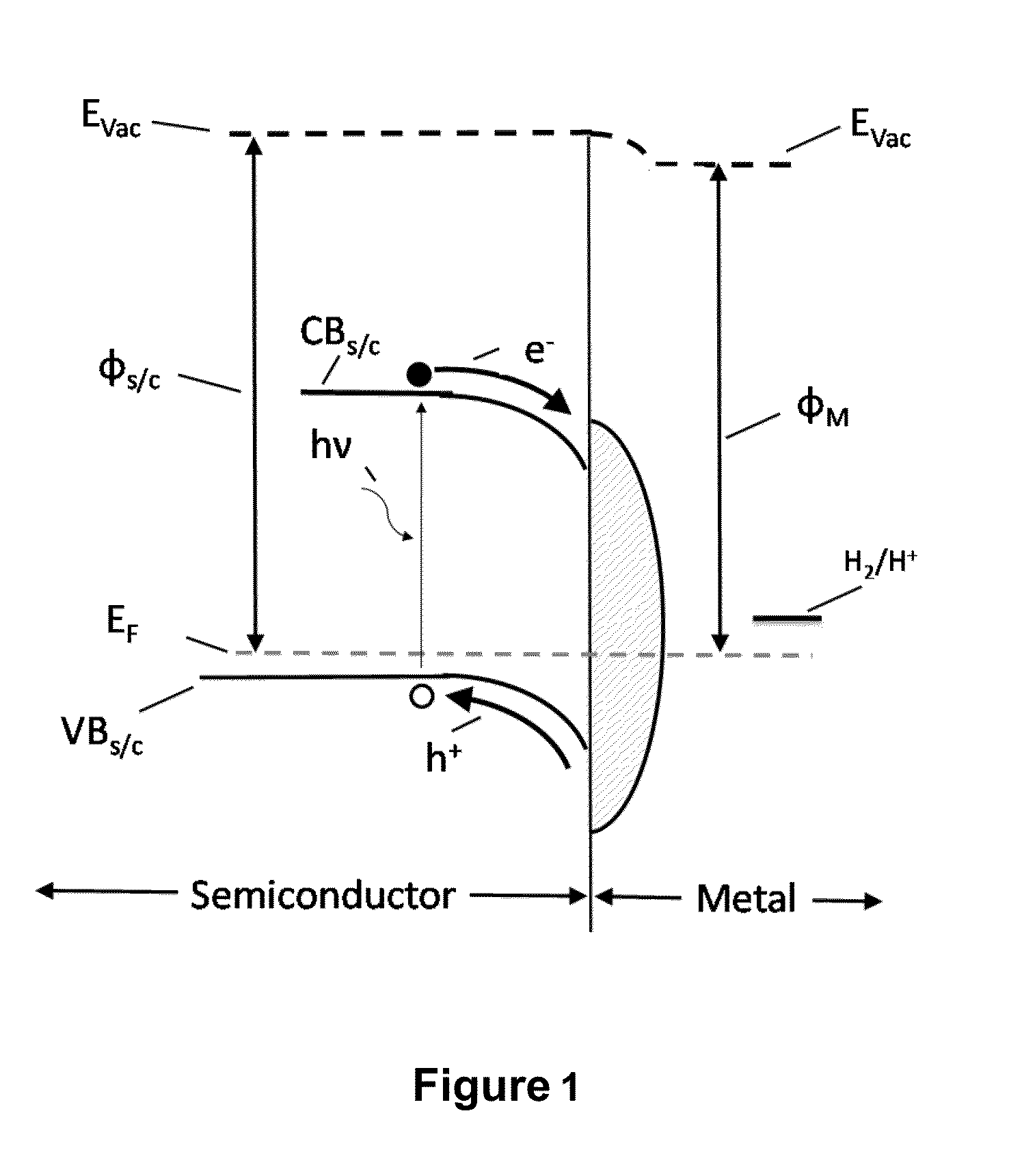Nanostructured solar selective catalytic supports
a selective surface, nano-structure technology, applied in the direction of physical/chemical process catalysts, metal/metal-oxide/metal-hydroxide catalysts, hydrocarbon preparation catalysts, etc., can solve the problems of broken performance metrics and environmental problems associated with burning fossil fuels, and achieve low emissivity and chemical reaction rates increase, the effect of low emissivity
- Summary
- Abstract
- Description
- Claims
- Application Information
AI Technical Summary
Benefits of technology
Problems solved by technology
Method used
Image
Examples
example 1
Efficient Photomethanation of Gaseous CO2 on Black Silicon Nanowire Catalyst Supports with Visible and Near-Infrared Photons
[0067]This example describes the fabrication and performance of Ru-based nanoparticle catalysts supported on silicon nanowire supports (Ru / SiNW) that exhibit photoactivity towards the Sabatier reaction when irradiated with a broadband source including UV-, visible and NIR photons. Specifically, at a constant temperature of 93° C., the Sabatier reaction proceeds five times faster when irradiated with photons between the spectral region of 615 nm and 1100 nm as compared to tests performed at the same temperature in the dark. Furthermore, when the Ru / SiNW catalyst is irradiated with photons in the NIR spectral range (850 nm<λ<1100 nm) the reaction rate is more than twice that of the dark reaction rate. This is the first demonstration that the Sabatier reaction can be photoactivated using near-infrared photons with energy 1.1 eV<hu<1.5 eV.
[0068]Silicon nanowires we...
example 2
Silicon Nanowire Supports as a Heat Source for Solar Powered Semiconductor Nanoparticle Photocatalysts
[0082]Generally speaking, SiNWs are an effective support for solar driven photocatalysts because they absorb 85% of the solar irradiance to generate EHPs across a 1.1 eV bandgap that can be used to thermochemically and / or photochemically drive solar fuels reactions. In this example SiNW supports were loaded with In2O3 nanoparticle photocatalysts that activated the reverse water-gas shift (RWGS) reaction (CO2+H2→CO+H2O) under solar simulated light. A cross-sectional SEM image of the In2O3 NPs loaded onto the SiNW support is shown in FIG. 8. The band-gap of these In2O3 NPs is ˜2.9 eV. Further, UV- and visible photons with wavelength less than ˜430 nm can activate these nanoparticles to drive the RWGS reaction. However, the optimal reaction temperature for these In2O3 NPs photocatalysts was about 150° C. In this example it is shown that the SiNW supports can absorb incident photons wit...
example 3
Broadband Tandem Solar Fuels Reactors that Split Water and Reduce CO2 to Methane
[0083]The ability of the Ru / SiNW catalyst shown in Example 1 to activate the Sabatier reaction using infrared photons has major implications for the design of tandem solar fuels reactors. These tandem reactors utilize the ultraviolet and visible portion of the solar irradiance to split water and generate H2 which can subsequently be used to reduce CO2. The general concept of this type of reactor is illustrated in FIG. 9 which shows a schematic diagram of a methane power plant and broadband solar fuels reactor integrated into a natural gas network cycle that recycles CO2 to CH4. The methane produced can be used for heating residential and commercial buildings and potentially transportation vehicles as well (Garthwaite, Natl Geogr, published on Sep. 4, 2013). FIG. 9b shows a schematic diagram illustrating that the idea that a thin catalyst film that utilizes UV- and visible photons to split water can be de...
PUM
| Property | Measurement | Unit |
|---|---|---|
| Diameter | aaaaa | aaaaa |
| Nanoscale particle size | aaaaa | aaaaa |
| Nanoscale particle size | aaaaa | aaaaa |
Abstract
Description
Claims
Application Information
 Login to View More
Login to View More - R&D
- Intellectual Property
- Life Sciences
- Materials
- Tech Scout
- Unparalleled Data Quality
- Higher Quality Content
- 60% Fewer Hallucinations
Browse by: Latest US Patents, China's latest patents, Technical Efficacy Thesaurus, Application Domain, Technology Topic, Popular Technical Reports.
© 2025 PatSnap. All rights reserved.Legal|Privacy policy|Modern Slavery Act Transparency Statement|Sitemap|About US| Contact US: help@patsnap.com



